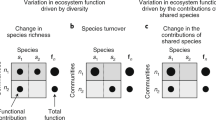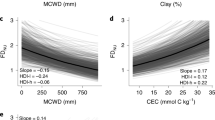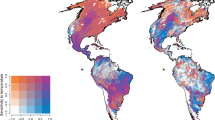Abstract
Understanding the relationship between biodiversity and ecosystem functioning has been a core ecological research topic over the past decades. Although a key hypothesis is that the diversity of functional traits determines ecosystem functioning, we do not know how much trait diversity is needed to maintain multiple ecosystem functions simultaneously (multifunctionality). Here, we uncovered a scaling relationship between the abundance distribution of two key plant functional traits (specific leaf area, maximum plant height) and multifunctionality in 124 dryland plant communities spread over all continents except Antarctica. For each trait, we found a strong empirical relationship between the skewness and the kurtosis of the trait distributions that cannot be explained by chance. This relationship predicted a strikingly high trait diversity within dryland plant communities, which was associated with a local maximization of multifunctionality. Skewness and kurtosis had a much stronger impact on multifunctionality than other important multifunctionality drivers such as species richness and aridity. The scaling relationship identified here quantifies how much trait diversity is required to maximize multifunctionality locally. Trait distributions can be used to predict the functional consequences of biodiversity loss in terrestrial ecosystems.
This is a preview of subscription content, access via your institution
Access options
Access Nature and 54 other Nature Portfolio journals
Get Nature+, our best-value online-access subscription
$29.99 / 30 days
cancel any time
Subscribe to this journal
Receive 12 digital issues and online access to articles
$119.00 per year
only $9.92 per issue
Buy this article
- Purchase on Springer Link
- Instant access to full article PDF
Prices may be subject to local taxes which are calculated during checkout





Similar content being viewed by others
References
Schmid, B . et al. in Biodiversity, Ecosystem Functioning, and Human Wellbeing: An Ecological and Economic Perspective (eds Naeem, S ., Bunker, D. E ., Hector, A ., Loreau, M . & Perrings, C. ) 14–29 (Oxford Univ. Press, 2009).
Hooper, D. U. et al. Effects of biodiversity on ecosystem functioning: a consensus of current knowledge. Ecol. Monogr. 75, 3–35 (2005).
Cardinale, B. J. et al. Biodiversity loss and its impact on humanity. Nature 486, 59–67 (2012).
Gamfeldt, L., Hillebrand, H. & Jonsson, P. R. Multiple functions increase the importance of biodiversity for overall ecosystem functioning. Ecology 89, 1223–1231 (2008).
Maestre, F. T. et al. Plant species richness and ecosystem multifunctionality in global drylands. Science 335, 214–218 (2012).
Grace, J. B. et al. Integrative modelling reveals mechanisms linking productivity and plant species richness. Nature 529, 390–393 (2016).
Gamfeldt, L. et al. Marine biodiversity and ecosystem functioning: what’s known and what’s next? Oikos 124, 252–265 (2015).
Lavorel, S. & Garnier, E. Predicting changes in community composition and ecosystem functioning from plant traits: revisiting the Holy Grail. Funct. Ecol. 16, 545–556 (2002).
Naeem, S. & Wright, J. P. Disentangling biodiversity effects on ecosystem functioning: deriving solutions to a seemingly insurmountable problem. Ecol. Lett. 6, 567–579 (2003).
Díaz, S. et al. Incorporating plant functional diversity effects in ecosystem service assessments. Proc. Natl Acad. Sci. USA 104, 20684–20689 (2007).
Violle, C. et al. Let the concept of trait be functional! Oikos 116, 882–892 (2007).
McGill, B. J., Enquist, B. J., Weiher, E. & Westoby, M. Rebuilding community ecology from functional traits. Trends Ecol. Evol. 21, 178–185 (2006).
Mayfield, M. M. & Levine, J. M. Opposing effects of competitive exclusion on the phylogenetic structure of communities. Ecol. Lett. 13, 1085–1093 (2010).
Maire, V. et al. Habitat filtering and niche differentiation jointly explain species relative abundance within grassland communities along fertility and disturbance gradients. New Phytol. 196, 497–509 (2012).
Garnier, E. et al. Plant functional markers capture ecosystem properties during secondary succession. Ecology 85, 2630–2637 (2004).
Naeem, S. et al. Declining biodiversity can alter the performance of ecosystems. Nature 368, 734–737 (1994).
de Bello, F. et al. Towards an assessment of multiple ecosystem processes and services via functional traits. Biodivers. Conserv. 19, 2873–2893 (2010).
Gross, N., Suding, K. N., Lavorel, S. & Roumet, C. Complementarity as a mechanism of coexistence between functional groups of grasses. J. Ecol. 95, 1296–1305 (2007).
Mouillot, D., Villéger, S., Scherer-Lorenzen, M. & Mason, N. W. Functional structure of biological communities predicts ecosystem multifunctionality. PLoS ONE 6, e17476 (2011).
Funk, J. L . et al. Revisiting the Holy Grail: using plant functional traits to understand ecological processes. Biol. Rev. http://dx.doi.org/10.1111/brv.12275 (2016).
Byrnes, J. E. et al. Investigating the relationship between biodiversity and ecosystem multifunctionality: challenges and solutions. Methods Ecol. Evol. 5, 111–124 (2014).
Lefcheck, J. S. et al. Biodiversity enhances ecosystem multifunctionality across trophic levels and habitats. Nat. Commun. 6, 6936 (2015).
Valencia, E. et al. Functional diversity enhances the resistance of ecosystem multifunctionality to aridity in Mediterranean drylands. New Phytol. 206, 660–671 (2015).
Kattge, J. et al. TRY–a global database of plant traits. Glob. Change Biol. 17, 2905–2935 (2011).
Enquist, B. J. et al. Scaling from traits to ecosystems: developing a general trait driver theory via integrating trait-based and metabolic scaling theories. Adv. Ecol. Res. 52, 249–318 (2015).
Díaz, S. et al. The global spectrum of plant form and function. Nature 529, 167–171 (2016).
Grime, J. P. Plant Strategies, Vegetation Processes, and Ecosystem Properties. (John Wiley & Sons, 2006).
Delgado-Baquerizo, M. et al. Microbial diversity drives multifunctionality in terrestrial ecosystems. Nat. Commun. 7, 10541 (2016).
Cristelli, M. Complexity in Financial Markets 141–150 (Springer, 2014).
Cornwell, W. K. & Ackerly, D. D. Community assembly and shifts in plant trait distributions across an environmental gradient in coastal California. Ecol. Monogr. 79, 109–126 (2009).
Kraft, N. J., Valencia, R. & Ackerly, D. D. Functional traits and niche-based tree community assembly in an Amazonian forest. Science 322, 580–582 (2008).
Le Bagousse-Pinguet, Y. et al. Testing the environmental filtering concept in global drylands. J. Ecol. http://dx.doi.org/10.1111/1365-2745.12735 (2017).
Schamp, B. S., Chau, J. & Aarssen, L. W. Dispersion of traits related to competitive ability in an old-field plant community. J. Ecol. 96, 204–212 (2008).
Gross, N. et al. Linking individual response to biotic interactions with community structure: a trait-based framework. Funct. Ecol. 23, 1167–1178 (2009).
MacArthur, R. & Levins, R. The limiting similarity, convergence, and divergence of coexisting species. Am. Nat. 101, 377–385 (1967).
Chesson, P. General theory of competitive coexistence in spatially-varying environments. Theor. Popul. Biol. 58, 211–237 (2000).
Cullen, A. C. & Frey, H. C. Probabilistic Techniques in Exposure Assessment: A Handbook for Dealing with Variability and Uncertainty in Models and Inputs (Springer, 1999).
Keddy, P. A. Assembly and response rules: two goals for predictive community ecology. J. Veg. Sci. 3, 157–164 (1992).
Weiher, E. et al. Advances, challenges and a developing synthesis of ecological community assembly theory. Phil. Trans. R. Soc. B 366, 2403–2413 (2011).
Levine, J. M. & HilleRisLambers, J. The importance of niches for the maintenance of species diversity. Nature 461, 254–257 (2009).
Gross, N., Liancourt, P., Butters, R., Duncan, R. P. & Hulme, P. E. Functional equivalence, competitive hierarchy and facilitation determine species coexistence in highly invaded grasslands. New Phytol. 206, 175–186 (2015).
Bardgett, R. D., Mommer, L. & De Vries, F. T. Going underground: root traits as drivers of ecosystem processes. Trends Ecol. Evol. 29, 692–699 (2014).
Delgado-Baquerizo, M. et al. Decoupling of soil nutrient cycles as a function of aridity in global drylands. Nature 502, 672–676 (2013).
García-Palacios, P ., McKie, B. G ., Handa, I. T ., Frainer, A & Hättenschwiler, S. The importance of litter traits and decomposers for litter decomposition: a comparison of aquatic and terrestrial ecosystems within and across biomes. Funct. Ecol. 30, 819–829 (2016).
Bolnick, D. I. et al. Why intraspecific trait variation matters in community ecology. Trends Ecol. Evol. 26, 183–192 (2011).
Siefert, A. et al. A global meta-analysis of the relative extent of intraspecific trait variation in plant communities. Ecol. Lett. 18, 1406–1419 (2015).
Crutsinger, G. M. et al. Plant genotypic diversity predicts community structure and governs an ecosystem process. Science 313, 966–968 (2006).
Wright, I. J. et al. The worldwide leaf economics spectrum. Nature 428, 821–827 (2004).
Enquist, B. J. Universal scaling in tree and vascular plant allometry: toward a general quantitative theory linking plant form and function from cells to ecosystems. Tree Physiol. 22, 1045–1064 (2002).
Pakeman, R. J. & Quested, H. M. Sampling plant functional traits: what proportion of the species need to be measured? Appl. Veg. Sci. 10, 91–96 (2007).
Grime, J. P. Benefits of plant diversity to ecosystems: immediate, filter and founder effects. J. Ecol. 86, 902–910 (1998).
Reiss, J., Bridle, J. R., Montoya, J. M. & Woodward, G. Emerging horizons in biodiversity and ecosystem functioning research. Trends Ecol. Evol. 24, 505–514 (2009).
Jax, K. Ecosystem Functioning (Cambridge Univ. Press, 2010).
Whitford, W. G. Ecology of Desert Systems (Academic, 2002).
Reynolds, J. F. et al. Global desertification: building a science for dryland development. Science 316, 847–851 (2007).
Pettorelli, N. et al. Using the satellite-derived NDVI to assess ecological responses to environmental change. Trends Ecol. Evol. 20, 503–510 (2005).
Loik, M. E., Breshears, D. D., Lauenroth, W. K. & Belnap, J. A multi-scale perspective of water pulses in dryland ecosystems: climatology and ecohydrology of the western USA. Oecologia 141, 269–281 (2004).
Hijmans, R. J., Cameron, S. E., Parra, J. L., Jones, P. G. & Jarvis, A. Very high resolution interpolated climate surfaces for global land areas. Int. J. Climatol. 25, 1965–1978 (2005).
Kembel, S. W. et al. Picante: R tools for integrating phylogenies and ecology. Bioinformatics 26, 1463–1464 (2010).
R Core Team. R: A Language and Environment for Statistical Computing (R Foundation for Statistical Computing, 2014).
Gotelli, N. J. & Entsminger, G. L. Swap and fill algorithms in null model analysis: rethinking the knight’s tour. Oecologia 129, 281–291 (2001).
Májeková, M. et al. Evaluating functional diversity: missing trait data and the importance of species abundance structure and data transformation. PLoS ONE 11, e0149270 (2016).
Burnham, K. P. & Anderson, D. R. Model Selection and Multimodel Inference: A Practical Information-Theoretic Approach (Springer, 2002).
Bartoń, K. MuMIn: multi-model inference. R package v. 1 (R Foundation for Statistical Computing, 2013).
Acknowledgements
This work was funded by the European Research Council (ERC) under the European Community’s Seventh Framework Programme (FP7/2007-2013)/ERC grant agreement 242658 (BIOCOM). Y.L.B.P was supported by a Marie Sklodowska-Curie Actions Individual Fellowship within the European programme Horizon 2020 (DRYFUN project 656035). N.G. was support by the AgreenSkills+ fellowship programme, which has received funding from the EU’s Seventh Framework Programme under grant agreement FP7-609398 (AgreenSkills+ contract). F.T.M. acknowledges support from the ERC (grant agreement 647038; BIODESERT). N.J.G. was supported by the US NSF DEB 1257625, NSF DEB 1144055 and NSF DEB 1136644. M.B. was supported by an FPU fellowship from the Spanish Ministry of Education, Culture and Sports (ref. AP2010-0759). We are very grateful to L. Börger, D. Eldridge, M. García-Gómez, V. Maire, M. Robson, H. Saiz and C. Violle for providing comments on previous versions of the manuscript, and to C. Mañá for explaining the statistical background on the skewness–kurtosis relationship.
Author information
Authors and Affiliations
Contributions
N.G., Y.L.B.P. and P.L. developed the original idea. F.T.M. designed and collected the ‘drylands’ data set. N.G., Y.L.B.P., N.J.G. and M.B. conducted the statistical analyses. N.G., Y.L.B.P. and P.L. wrote the article, with major contributions from F.T.M., M.B. and N.J.G.
Corresponding authors
Ethics declarations
Competing interests
The authors declare no competing financial interests.
Supplementary information
Supplementary Information
Supplementary Notes 1–5; Supplementary References; Supplementary Tables 1–3; Supplementary Figures 1–3 (PDF 2964 kb)
Rights and permissions
About this article
Cite this article
Gross, N., Bagousse-Pinguet, Y., Liancourt, P. et al. Functional trait diversity maximizes ecosystem multifunctionality. Nat Ecol Evol 1, 0132 (2017). https://doi.org/10.1038/s41559-017-0132
Received:
Accepted:
Published:
DOI: https://doi.org/10.1038/s41559-017-0132
This article is cited by
-
Intraspecific demographic and trait responses to environmental change drivers are linked in two species of ciliate
BMC Ecology and Evolution (2024)
-
Effects of habitat regime type on fish diversity in a large eutrophic lake
Hydrobiologia (2024)
-
Response of functional diversity of fish communities to habitat alterations in small lowland rivers
Biodiversity and Conservation (2024)
-
Shifts in plant resource use strategies across climate and soil gradients in dryland steppe communities
Plant and Soil (2024)
-
Key questions for understanding drivers of biodiversity-ecosystem service relationships across spatial scales
Landscape Ecology (2024)



